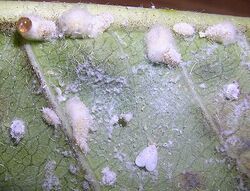Biology:Paracoccus marginatus
| Paracoccus marginatus | |
|---|---|

| |
| Male and female papaya mealybugs | |
| Scientific classification Error creating thumbnail: Unable to save thumbnail to destination
| |
| Domain: | Eukaryota |
| Kingdom: | Animalia |
| Phylum: | Arthropoda |
| Class: | Insecta |
| Order: | Hemiptera |
| Suborder: | Sternorrhyncha |
| Family: | Pseudococcidae |
| Genus: | Paracoccus |
| Species: | P. marginatus
|
| Binomial name | |
| Paracoccus marginatus | |
Paracoccus marginatus, commonly known as the papaya mealybug, is a small sap-sucking insect in the mealybug family, Pseudococcidae. It is found on a number of different hosts, including economically important tropical fruit trees and various ornamental plants.
Description
The adult female has a yellowish segmented, flattened oval body about two millimetres long covered with mealy wax. There are a number of short waxy filaments projecting around the margin. The ovisac is well developed and visible underneath the posterior part of the body. Sometimes the wax looks like cotton wool and oozes drops of fluid. The adult male is pinkish and about one millimetre long, with well-developed wings each marked with a small basal vein.[1] The antennae have eight segments in both sexes, a characteristic which distinguishes this species from the hibiscus mealybug (Maconellicoccus hirsutus).[2]
Distribution
This species is believed to be native to Belize, Costa Rica, Guatemala and Mexico.[3] It has spread to certain Caribbean Islands, Hawaii and French Guiana,[4] and also to parts of Southeast Asia, including India, Indonesia and Thailand.[1] It was discovered in Bradenton, Florida, in the United States in 1998 feeding on hibiscus, and four years later it had been detected on eighteen different plant species in the state. It has since been found in Texas and California and it is likely to become more widely distributed on the Gulf Coast, and perhaps also in crops grown under glass further north in the United States.[2] The introduction of this species has caused damage to papaya cultivation in South India, especially in the states of Karnataka, Kerala and Tamil Nadu.[5] It has also invaded Assam - a northeastern state of India.[6] It was recently noted in Réunion in the Indian Ocean.[7]
Host plants
The papaya mealybug feeds on over 55 plants in more than 25 genera. Economically important host plants include papaya, avocado, citrus, mango, cherry and pomegranate, as well as hibiscus, cotton, tomato, eggplant, peppers, beans, peas and sweet potato.[2] The mango is more affected by the mango mealybug.[8]
Biology
The adult female deposits up to six hundred eggs into her ovisac over a period of one to two weeks. The eggs hatch ten days later and the crawlers, which resemble miniature versions of the adult female, disperse. There are four instars in the females and five in the males. The fifth instar male is a pupa in which the nymph undergoes metamorphosis into a winged adult.[2]
Damage
The papaya mealybug inserts its stylet into the epidermis of the leaf or the skin of fruit or stem and feeds on the plant sap. At the same time it injects a toxic substance into the plant which results in chlorosis, distortion, stunting, early leaf and fruit fall, the production of honeydew, sooty mould and possibly the death of the plant.[2]
Biological control
Natural enemies of the papaya mealybug include the mealybug destroyer (Cryptolaemus montrouzieri), other lady beetles, lacewings and hoverflies. The larvae of several species of parasitoid wasp in the family Encyrtidae attack the papaya mealybug in its native range.
In 1999, the USDA Animal and Plant Health Inspection Service and Agricultural Research Service collected and reared four species of wasp from Mexico in a biological pest control experiment. They introduced them into Puerto Rico and the Dominican Republic and achieved a reduction of the papaya mealybug populations in both countries of over 95%.[9] All four wasps were observed parasitising second and third instars of the papaya mealybug, and Acerophagus papayae was the dominant species.[10] All four have since been mass-reared and released in Florida.[2]
References
- ↑ 1.0 1.1 National Bureau of Agriculturally Important Insects
- ↑ 2.0 2.1 2.2 2.3 2.4 2.5 Walker, A., et al. Paracoccus marginatus. EENY-302. Featured Creatures. Entomology and Nematology. University of Florida IFAS. Published 2003, revised 2006.
- ↑ Williams, D. J. and M. C. Granara de Willink. 1992. Mealybugs of Central and South America. CAB International, UK, 644 pp.
- ↑ Miller, D. R. and G. L. Miller. 2002. Redescription of Paracoccus marginatus Williams and Granara de Willink (Hemiptera: Coccoidea: Pseudococcidae), including descriptions of the immature stages and adult male. Proceedings of the Entomological Society of Washington 104: 1-23.
- ↑ "Papaya mealybug, Paracoccus marginatus". National Bureau of Agriculturally Important Insects. 9 September 2011. Archived from the original on 21 July 2011. https://web.archive.org/web/20110721181104/http://www.nbaii.res.in/Introductions/Insects/Paracoccus-marginatus.htm. Retrieved 23 October 2011.
- ↑ Sarma, A. K.. "Invasion of papaya mealy bug, Paracoccus marginatus in Assam.". Centre for Agriculture and Bioscience International. https://www.cabi.org/ISC/abstract/20143022947.
- ↑ [1][yes|permanent dead link|dead link}}]
- ↑ Hussain SI, Saleem MA and Freed S (2012). "Toxicity of some intsecticides to control mango mealybug, Drosicha mangiferae, a serious pest of mango in Pakistan". Pakistan Journal of Zoology 44 (2): 353–359. http://zsp.com.pk/pdf44/353-359%20_8_%20PJZ-572-10.pdf.
- ↑ U.S. Department of Agriculture, Animal and Plant Health Inspection Service. 2000. Control of the papaya mealybug, Paracoccus marginatus (Homoptera: Pseudococcidae). Environmental Assessment (Supplement), June 2000. Riverdale, MD.
- ↑ Meyerdirk, D. E. and W. C. Kauffman. 2001. Status on the development of a biological control program for Paracoccus marginatus Williams, papaya mealybug. Internal USDA, APHIS, PPQ Report.
Wikidata ☰ Q7133993 entry
 |

